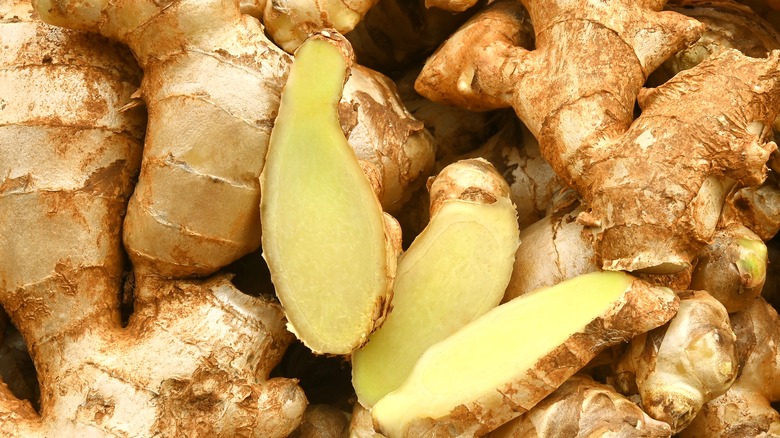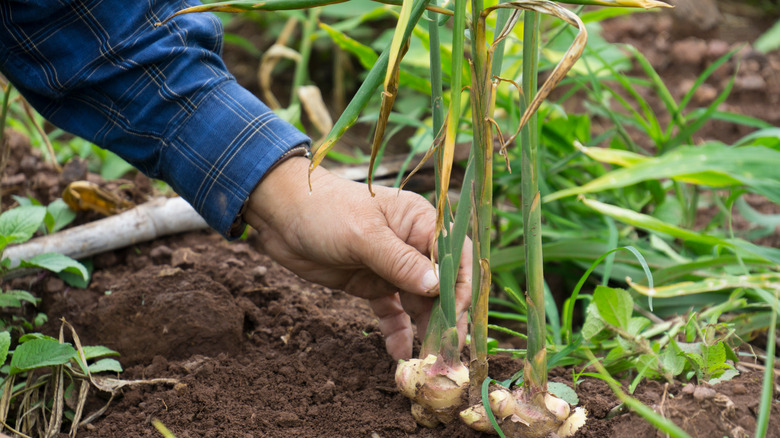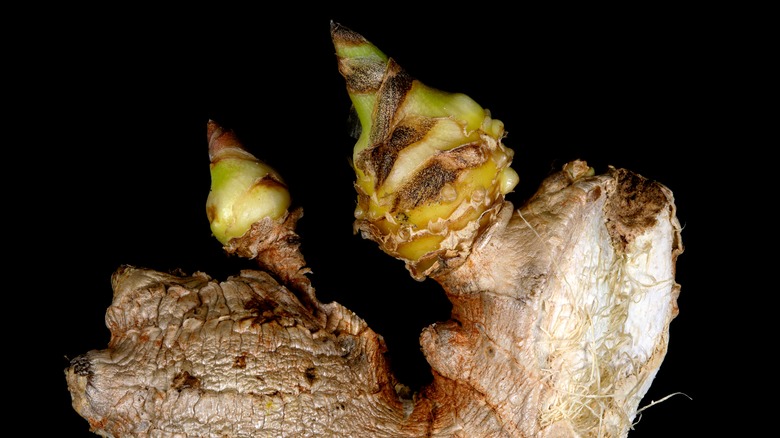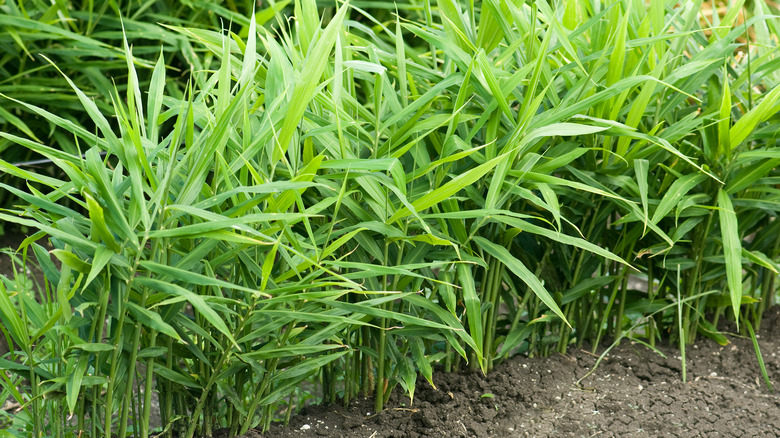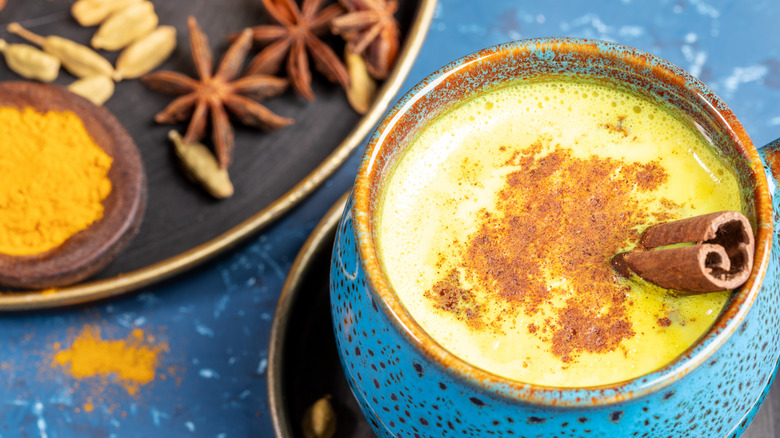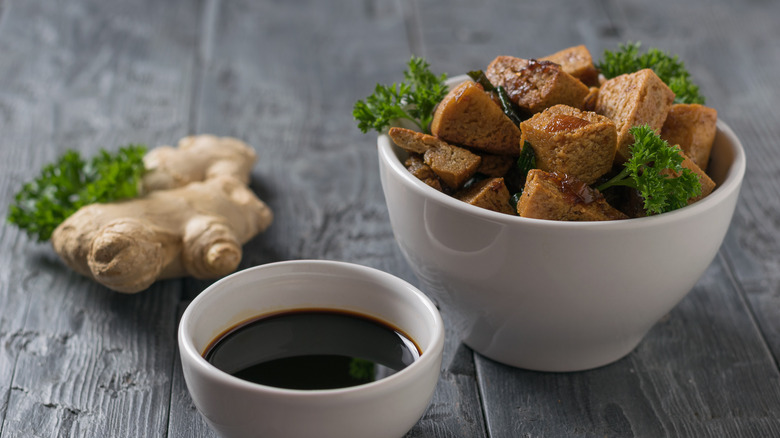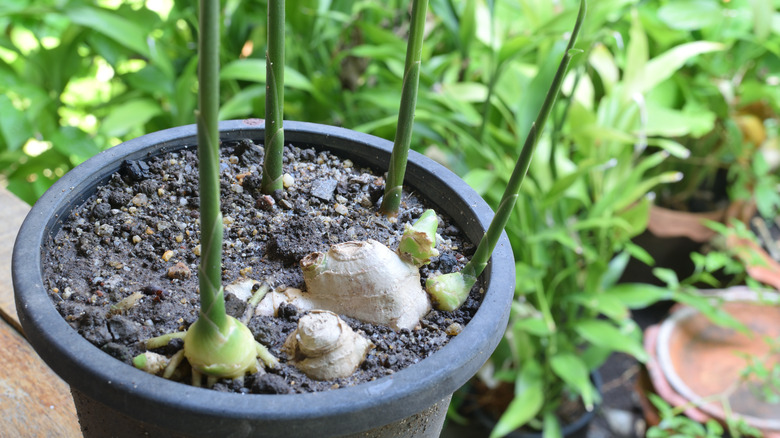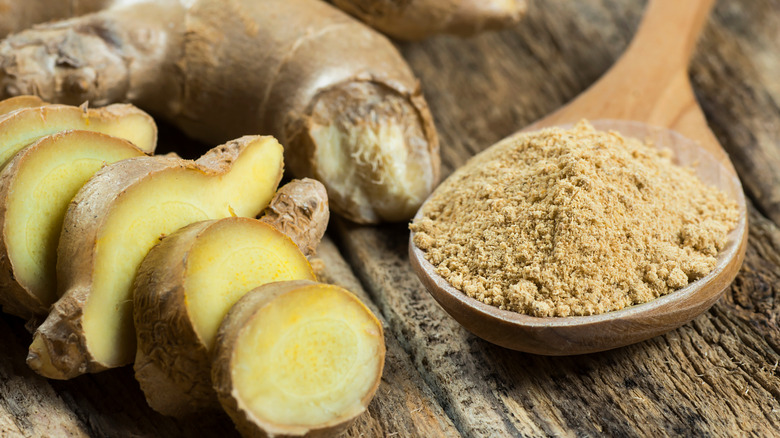Culinary Ginger Plants: Everything To Know Before Planting
Culinary ginger is a perennial star among home cooks and gourmet chefs alike, and for good reason. When freshly peeled, sliced, shredded, or diced, Zingiber officinale offers up a pungent, spicy yet sweet flavor that adds a lot of life to cooked meals, salad dressings, baked goods, and beverages. As a powder, it can be used as a spice or an encapsulated supplement. The essential oils found in ginger are also extracted from its rhizome for use in aromatherapy as well as hair growth and anti-wrinkle skin treatments.
Culinary ginger is a tropical plant native to southeast Asia and it's one of the most widely cultivated crops in the world. In Sanskrit, it's called srngaveram, a word that dates back more than 3,000 years and translates to horn root. Wisconsin Horticulture explains that its most common name, ginger root, is a misnomer because the flesh we eat is actually an underground rhizome. Essentially, the rhizome shoots its stems up above the surface of the soil to grow leaves, bracts, and flowers while also shooting roots down into the earth to anchor the plant in the ground. Accurate botanical references notwithstanding, Zingiber officinale is known around the world as ginger root, and it is celebrated for its distinct flavor profile as well as its widely confirmed herbal and medicinal properties.
How to use culinary ginger in a garden
Culinary ginger root makes an excellent addition to your home-based vegetable garden for its ease of growth as well as its pungent scent, which will naturally repel insects away from your other burgeoning plants. When designing your garden layout, first pick a spot that will receive plenty of sun. Then be sure to allow space for your baby plants to spread, as the rhizomes will grow horizontally below the ground.
As for the best companions to plant nearby, a general rule of thumb is to arrange vegetables that could be mutually beneficial next to one another. Sometimes it's as simple as plants that require the same soil conditions. Other times it's a more crucial benefit involving pest repellent or nutrient density. In the case of ginger, Grow Veggy lists chili peppers, cilantro, and legumes, among a few others. Just be careful not to plant ginger next to something that will grow so large it risks obstructing too much sunlight. If you don't have in-ground garden space, you can also grow ginger plants in containers on a deck or porch. Consider growing both ginger root and turmeric in the same wide pot.
How to grow culinary ginger
Shown above, the eyes of a piece of ginger root are where new growth will sprout. When shopping for a starter piece, Epic Gardening notes that for quicker overall growth, you should choose the largest piece. It will have more eyes, meaning more aboveground shoots capturing energy from the sun for photosynthesis.
A wide, shallow container will allow for that horizontal spreading of the rhizome. Ensure that your container has proper drainage before filling it with high-quality potting soil. Bury the entire piece of ginger half an inch down and tamp the surface to secure it into place. Saturate the soil with water and move the container to an area that will have consistent warmth and moisture. New plants need 10 months before being ready to harvest. In turn, they must be harvested before the first frost. In cooler climates, start your grow pots indoors before transplanting them into the ground when it's warm enough.
Per Gardening Know How, you'll know it's time to harvest your crop after the shoots have blossomed and the leaves dry up. In zone seven or above, you can harvest the entire plant or take only what you'll use and leave the rest of the rhizomes to keep growing. In colder zones, rhizomes can be stored indoors above 55ºF and replanted in the spring. All you really need to get your ginger patch started is a couple of pieces of fresh ginger from the market.
How to care for culinary ginger plants
With all the important growth happening below the surface, the view from aboveground will be far from spectacular. You can still monitor the health of your plants by observing its leaf shoots. Discoloration on the tips will clue you in to signs of distress, most likely the result of improper watering. Is the topsoil dried out and cracking? A layer of mulch can help retain moisture and protect the rhizomes from exposure.
Commercial growers will test their soil for nutrients before planting a major crop, but that's likely not possible for the majority of us novice home gardeners. Assuming most yards have somewhat depleted soil, experts from the AgriLife Extension at Texas A&M recommend a high-phosphorous fertilizer for ginger root. In general, all vegetables will benefit from extra phosphorous when it comes to root development and flowering or fruiting, so don't worry if your application crosses over to your other plants. Start by applying fertilizer on a bi-weekly basis and see how it goes before making further changes.
Heavy rainfall can flush away nutrients, making regular fertilization even more important. Also, keep in mind that a soggy plant can develop root rot and send you back to the supermarket to start all over. If your garden is flooding, it may be time to invest in raised beds or more containers.
Ginger plant varieties
There are a few other members of the Zingiberaceae ginger family that are used for culinary purposes, including cardamom (Elettaria cardamomum), galangal (Alpinia galanga), and turmeric (Curcuma longa). Galangal and turmeric look very similar to ginger root until you slice them open and see the different colors of their flesh. Cardamom, however, originates as a seed pod that can be ground or used whole.
- Cardamom is the main ingredient in most chai recipes, but it can also be found in many Indian dishes. Although it is native to South India, Guatemala is the country that produces and exports the bulk of this spice. According to Delish, German coffee bean farmers were the first to grow it there.
- Galangal flesh is paler and harder than ginger and its taste has a strong punch of citrus. Galangal is readily found in Thai, Malaysian, and Indonesian cuisine.
- Turmeric is the fundamental component of Ayurvedic Golden Milk (pictured above). As reported by Art of Living, this delicious concoction, called Haldi doodh in Hindi, is heralded for its ability to decrease inflammation, joint pain, and blood sugar. Turmeric may also help in the fight against cancer and memory loss.
Ornamental gingers also come from the same botanical family, but they do not produce a rhizome suitable for consumption. Not all is lost, though, because the stunning tropical flowers from these plants never disappoint! They vary greatly in size, shape, and color.
Is culinary ginger toxic?
Culinary ginger is not toxic. It may register as sharp and spicy on the tastebuds, but it is the opposite of poisonous. Not only is it a common ingredient in food dishes from around the world, but it also touts many confirmed herbal and medicinal benefits. In Asian cooking, it is often used in stir-fries and curries, as per Master Class. In baking, it is a staple for treats such as gingerbread and ginger snap cookies. And let's not forget one of its most common commercial uses: the main ingredient for ginger ale, tea, and beer.
Nutritionally speaking, ginger is high in antioxidants. This means it can help reduce arthritis pain. In traditional medicine and home remedies, it is often used to aid in digestion or to help soothe an already upset stomach, explains WebMD. Gingerol is the name given to the pungent bioactive compounds thought to produce these medicinal properties (via PEAK Scientific).
Although fairly rare in occurrence, it is possible to develop an allergic reaction to ginger. HealthLabs reports that symptoms will likely be skin-related; for instance, a rash or other type of inflammation. Seek care from a qualified medical professional when warranted.
How to repot culinary ginger plants
When cared for in appropriate environmental conditions, a healthy ginger rhizome can flourish for years. Repotting will be necessary each time the rhizome outgrows its container or until you are ready to transplant it into your garden. As with all rhizomatous plants, division is an essential aspect of repotting. That means you won't need a larger pot so much as a few extra small ones.
Green Plants has an excellent visual tutorial that will walk you through the entire process from planting an initial piece to harvesting, dividing, and replanting new pieces. Start by delicately digging up the entire plant. Wash away any residual soil and use a clean, sharp knife to cut away the stems and roots. Once you're left with just the rhizome, begin to break it up into smaller pieces. These can either be used or replanted into individual grow pots with fresh nutrient-dense potting soil. In larger pots, you can plant multiple rhizomes so long as they each have sufficient room for expansion. As always, ensure proper drainage, water well, and keep the containers warm. While your new plants sprout and grow, you'll find plenty of uses for your harvested ginger root.
Ways to use culinary ginger
There is a slew of uses for ginger in its many different forms. Fresh ginger is usually sliced or grated and offers the strongest flavor profile. Powdered ginger can also add a high dose of spice when generously added to both sweet and savory dishes. As a powder, ginger root will have a much longer shelf life than a harvested rhizome. Another use you may be familiar with is the pickled ginger commonly found alongside maki rolls from a sushi restaurant. Recipe creators at The Spruce Eats say pickled ginger, or gari as it is known in Japan, is easy to make at home with salt, sugar, and rice vinegar. Crystallized or candied ginger has become a popular way to get this good-for-you spice into your diet as well.
When used as a supplement, ginger root claims a long list of benefits taken seriously not only by traditional healers, but by experts like the dietitians at Johns Hopkins Medicine. Ginger is extremely effective as a digestive aid by relieving nausea, gas, and bloating. It also encourages food to move through the digestive process faster. As a tea, it makes an excellent post-dinner hot beverage, especially throughout the winter. Teabags can be bought at the store, but you might prefer to make the tea on your own. All it takes is a fresh piece of ginger peeled and sliced, then left to steep in boiling water for 10 minutes or more. Relax, sip, and enjoy!
